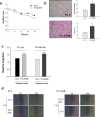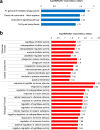Secretome profiling of PC3/nKR cells, a novel highly migrating prostate cancer subline derived from PC3 cells
- PMID: 31404090
- PMCID: PMC6690527
- DOI: 10.1371/journal.pone.0220807
Secretome profiling of PC3/nKR cells, a novel highly migrating prostate cancer subline derived from PC3 cells
Erratum in
-
Correction: Secretome profiling of PC3/nKR cells, a novel highly migrating prostate cancer subline derived from PC3 cells.PLoS One. 2019 Sep 13;14(9):e0222693. doi: 10.1371/journal.pone.0222693. eCollection 2019. PLoS One. 2019. PMID: 31518368 Free PMC article.
Abstract
Prostate cancer (PCa) is the most common cancer among men worldwide. Most PCa cases are not fatal; however, the outlook is poor when PCa spreads to another organ. Bone is the target organ in about 80% of patients who experience metastasis from a primary PCa tumor. In the present study, we characterized the secretome of PC3/nKR cells, which are a new subline of PC3 cells that were originally isolated from nude mice that were implanted with PC3 cells without anti-natural killer (NK) cell treatment. Wound healing and Transwell assays revealed that PC3/nKR cells had increased migratory and invasive activities in addition to a higher resistance to NK cells-induced cytotoxicity as compared to PC3 cells. We quantitatively profiled the secreted proteins of PC3/nKR and PC3 cells by liquid chromatography-tandem mass spectrometry analysis coupled with 2-plex tandem mass tag labeling. In total, 598 secretory proteins were identified, and 561 proteins were quantified, among which 45 proteins were secreted more and 40 proteins were secreted less by PC3/nKR cells than by PC3 cells. For validation, the adapter molecule crk, serpin B3, and cystatin-M were analyzed by western blotting. PC3/nKR cells showed the selective secretion of NKG2D ligand 2, HLA-A, and IL-6, which may contribute to their NK cell-mediated cytotoxicity resistance, and had a high secretion of crk protein, which may contribute to their high migration and invasion properties. Based on our secretome analysis, we propose that PC3/nKR cells represent a new cell system for studying the metastasis and progression of PCa.
Conflict of interest statement
The authors have declared that no competing interests exist.
Figures





Similar articles
-
Correction: Secretome profiling of PC3/nKR cells, a novel highly migrating prostate cancer subline derived from PC3 cells.PLoS One. 2019 Sep 13;14(9):e0222693. doi: 10.1371/journal.pone.0222693. eCollection 2019. PLoS One. 2019. PMID: 31518368 Free PMC article.
-
Exosomes secreted by prostate cancer cells under hypoxia promote matrix metalloproteinases activity at pre-metastatic niches.Mol Carcinog. 2020 Mar;59(3):323-332. doi: 10.1002/mc.23157. Epub 2020 Jan 14. Mol Carcinog. 2020. PMID: 31943365 Free PMC article.
-
Regulation of prostate cancer cell migration toward bone marrow stromal cell-conditioned medium by Wnt5a signaling.Mol Med Rep. 2013 Nov;8(5):1486-92. doi: 10.3892/mmr.2013.1698. Epub 2013 Sep 23. Mol Med Rep. 2013. PMID: 24064566
-
HO-1 Interactors Involved in the Colonization of the Bone Niche: Role of ANXA2 in Prostate Cancer Progression.Biomolecules. 2020 Mar 18;10(3):467. doi: 10.3390/biom10030467. Biomolecules. 2020. PMID: 32197509 Free PMC article.
-
[Roles of highly expressed bone-specific genes in bone metastatic prostate cancer PC3 cells: Advances in studies].Zhonghua Nan Ke Xue. 2021 Oct 20;27(10):927-933. Zhonghua Nan Ke Xue. 2021. PMID: 34914272 Review. Chinese.
Cited by
-
Correction: Secretome profiling of PC3/nKR cells, a novel highly migrating prostate cancer subline derived from PC3 cells.PLoS One. 2019 Sep 13;14(9):e0222693. doi: 10.1371/journal.pone.0222693. eCollection 2019. PLoS One. 2019. PMID: 31518368 Free PMC article.
-
sBioSITe enables sensitive identification of the cell surface proteome through direct enrichment of biotinylated peptides.Clin Proteomics. 2023 Dec 5;20(1):56. doi: 10.1186/s12014-023-09445-6. Clin Proteomics. 2023. PMID: 38053024 Free PMC article.
-
OH2 oncolytic virus inhibits non-small-cell lung cancer metastasis via β-catenin pathway suppression.Commun Biol. 2025 Jul 28;8(1):1115. doi: 10.1038/s42003-025-08520-y. Commun Biol. 2025. PMID: 40721857 Free PMC article.
References
-
- Society AC. Cancer Statistics Center, https://cancerstatisticscenter.cancer.org/#!/cancer-site/Prostate. 2017.
Publication types
MeSH terms
Substances
LinkOut - more resources
Full Text Sources
Medical
Molecular Biology Databases
Research Materials

